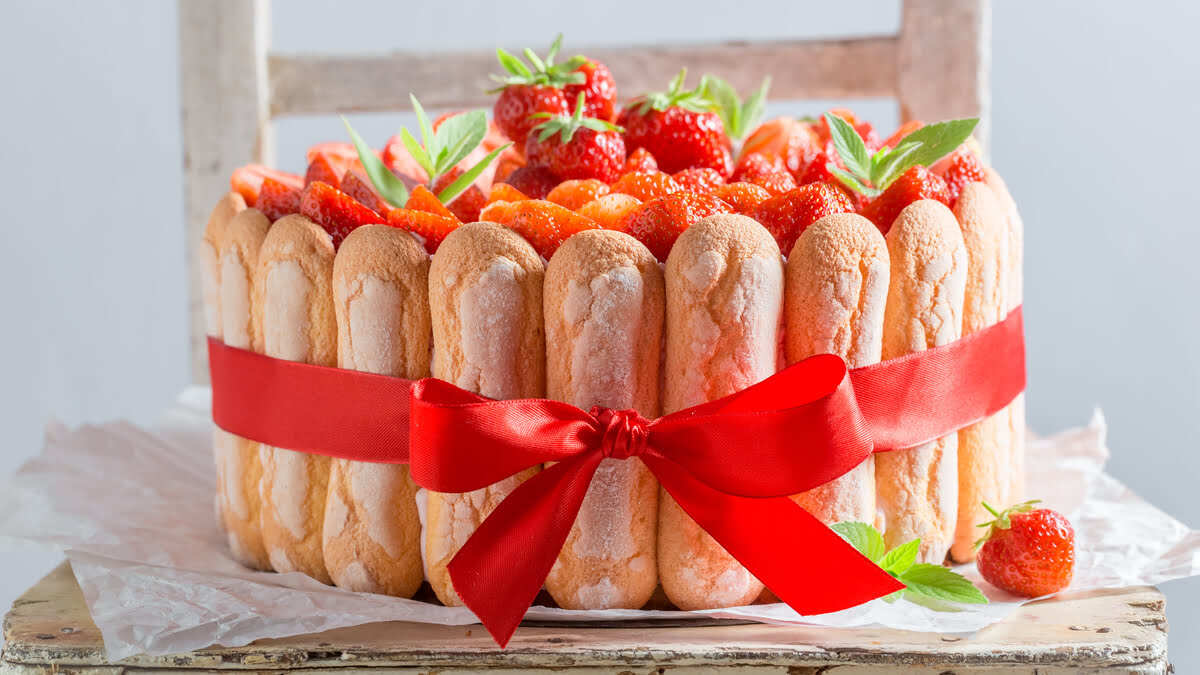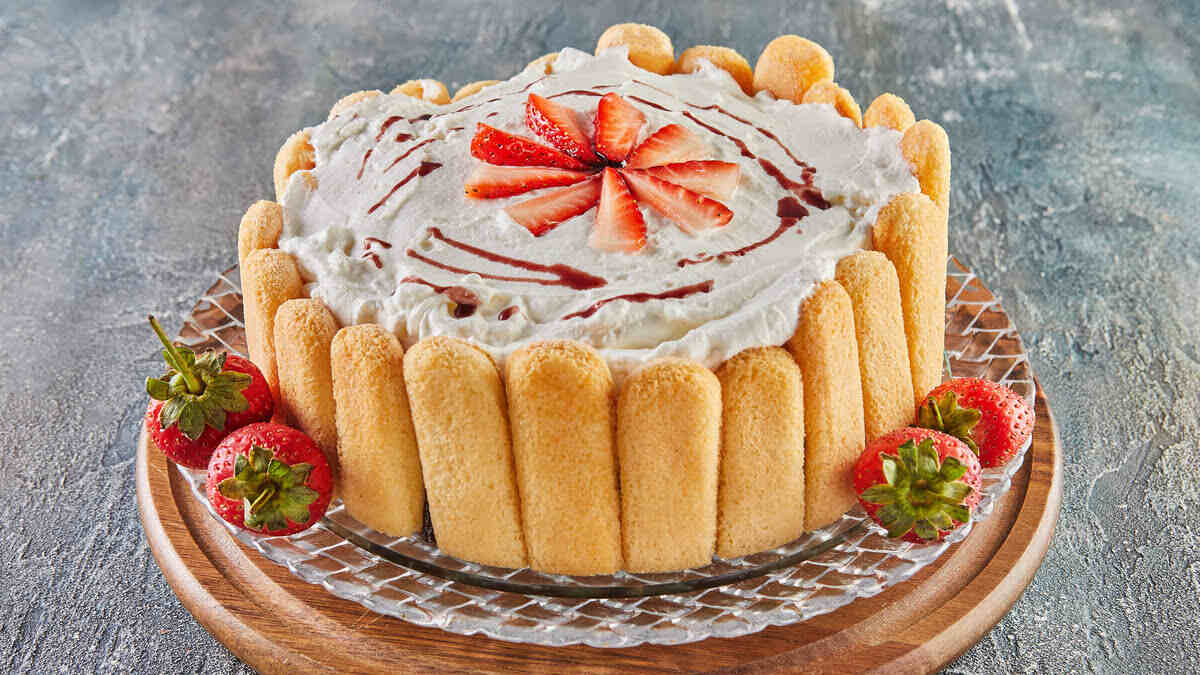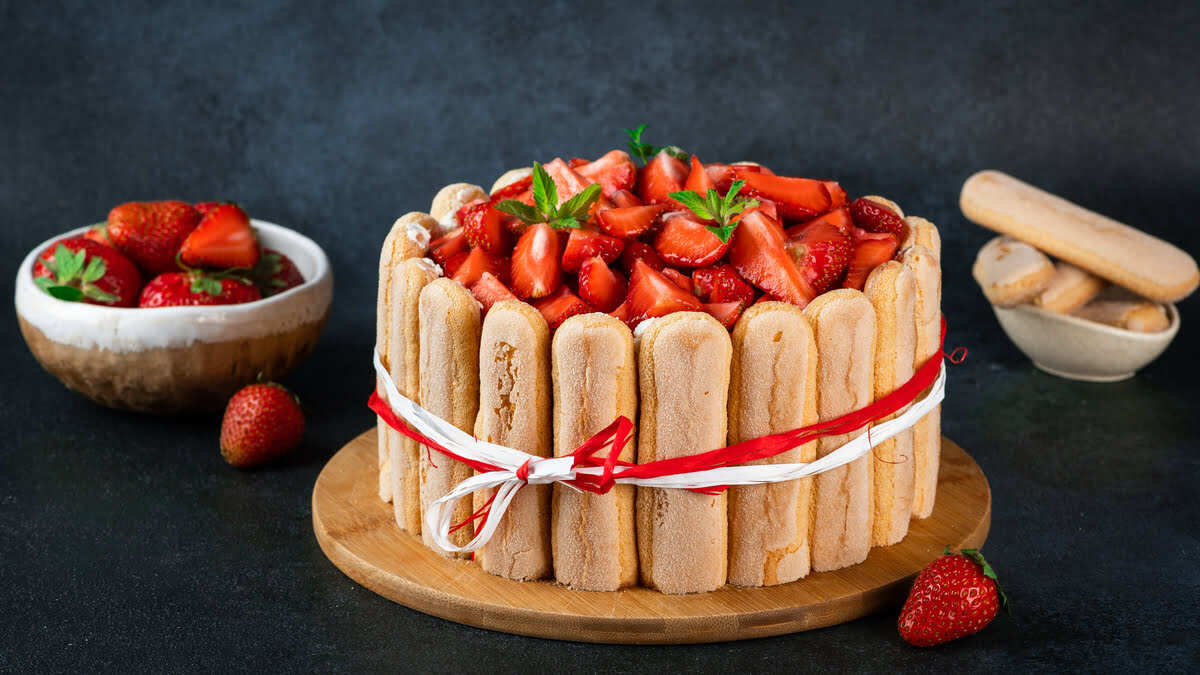Looking for a no-bake dessert idea? Try Charlotte cake.
No-bake desserts enjoy unwavering popularity—they are quick to prepare, eye-catching, and ideal for practically any occasion. In summer, when heat discourages turning on the oven, light and refreshing sweets become the true stars of home gatherings. One such dessert, which delights both in appearance and taste, is the Charlotte cake.
This classic treat combines the delicacy of ladyfinger biscuits, the velvety smoothness of cream, and the freshness of seasonal fruit. So if you’re looking for an idea for an exceptional no-bake dessert, be sure to discover the Charlotte cake recipe and see how easily you can create a culinary masterpiece in your own kitchen.
What is a Charlotte cake?
The Charlotte cake is a classic dessert that has delighted for years with its elegance and versatility. Its characteristic feature is the use of ladyfinger biscuits, which create an impressive “crown” around the delicate interior. Inside the Charlotte cake, there are most often fluffy mixtures based on whipped cream, mascarpone, or a light custard cream, enriched with fresh seasonal fruit. Interestingly, the dessert does not require baking.
Charlotte cake | History
The Charlotte cake, also known as Charlotte Russe, is a classic dessert whose history dates back to the early 19th century. Its creator was Marie-Antoine Carême (1784–1833), one of the greatest French chefs, considered a pioneer of haute cuisine. Carême created this elegant dessert by combining ladyfinger biscuits with Bavarian cream—a light mousse based on crème anglaise, gelatin, and whipped cream.
The name “Charlotte” was meant to honor the English Princess Charlotte (1796–1817), daughter of King George IV. The term “Russe” (Fr. “Russian”) may have referred to Tsar Alexander I (1777–1825), whom Carême also served as a chef. In some sources, Carême referred to this dessert as “Charlotte à la Parisienne,” but over time the name “Charlotte Russe” gained greater popularity.

In its classic form, the Charlotte cake consists of a mold lined with ladyfingers, filled with Bavarian cream, and chilled until set. This dessert quickly won favor among the European aristocracy, and its popularity spread to other continents. In the United States, particularly in New York, simplified versions of Charlotte Russe were sold in confectioneries and candy stores in the 1930s, 1940s, and 1950s. They consisted of a portion of sponge cake, whipped cream, and a maraschino cherry, served in paper cups with a movable bottom, which made the dessert easy to eat.
Today, the Charlotte cake appears in many variations, from traditional to modern interpretations with a variety of additions, such as fruit, chocolate, or fruit jellies. Regardless of the version, it remains a symbol of elegance and refined taste in the world of desserts.
Charlotte cake and its varieties
The Charlotte cake is a dessert with many faces that has gained popularity thanks to its elegance and range of flavors. The classic version consists of ladyfinger biscuits surrounding a creamy interior, often enriched with fresh fruit. However, over the years numerous variants of this treat have emerged, tailored to different tastes and occasions.
Charlotte Russe
One of the best-known versions of the Charlotte cake is Charlotte Russe, characterized by a filling of Bavarian cream—a light mousse based on whipped cream and gelatin. This dessert is served cold, which makes it an ideal choice for summer parties.
Charlotte Royale
Charlotte Royale is an impressive variant in which traditional ladyfingers are replaced by slices of sponge roll. The interior is filled with fruit mousse or cream, and the whole forms an impressive mosaic when cut. This version often appears on special occasions, delighting both in taste and appearance.
Fruit Charlotte
Fruit versions of the Charlotte cake are very popular, especially in the summer season. Raspberry Charlotte or Strawberry Charlotte are light desserts in which cream combines with a pronounced fruit mousse. These desserts do not require baking and are perfect for First Communion parties or summer gatherings.
Chocolate Charlotte
For lovers of intense flavors, there is the Chocolate Charlotte, in which a chocolate cream or mousse forms the main filling. It is often decorated with fruits such as pears or raspberries, which pair perfectly with the chocolate interior.
Charlotte with fruit jelly
Modern interpretations of the Charlotte cake often include fruit jelly, which adds additional texture and intense flavor to the dessert. An example might be a version with cranberry–orange jelly, surrounded by ladyfingers and filled with mascarpone cream with a citrus note.
Charlotte cake step by step
The Charlotte cake is an excellent proposition for an elegant, chilled dessert that delights with lightness and fruity freshness. Based on the traditional French recipe created in honor of the English Princess Charlotte, the dessert combines creamy delicacy and intense fruit notes. Below we present a recipe that will make preparing this impressive cake a real pleasure.

Ingredients:
Ladyfingers:
- 150–200 g ladyfinger biscuits.
Fruit cream:
- 250 g mascarpone,
- 200 ml heavy cream 36%,
- 50 g powdered sugar,
- 3 teaspoons gelatin,
- 200 g fresh strawberries.
Fruit mousse:
- 400 g selected fruit (e.g., raspberries, blueberries, strawberries, currants),
- 100 g sugar,
- 2 teaspoons gelatin,
- 250 ml heavy cream 36%.
Method:
Fruit cream:
Dissolve the gelatin in about 50 ml of hot water, stirring carefully to achieve a uniform consistency. In a separate bowl, combine mascarpone with powdered sugar, then add chilled heavy cream. Beat everything on medium mixer speed until a thick, stable cream is obtained. Gently mix the cleaned and chopped strawberries with the cream mixture, adding the cooled gelatin.
Assembly of the first layer:
Line a springform pan about 20 cm in diameter with ladyfingers, placing them vertically along the sides of the pan. Gently pour the prepared fruit cream into the pan, filling it halfway up the ladyfingers. Place the cake in the freezer for about an hour so the mixture sets properly.
Fruit mousse:
Dissolve the gelatin in hot water. Heat the selected fruit with sugar over low heat for a few minutes until they begin to release juice and soften slightly. Then blend into a smooth puree—if necessary, pass through a sieve to remove seeds. Add the dissolved gelatin to the cooled puree and mix thoroughly. Whip the heavy cream until stiff and gently fold it into the fruit puree.
Assembly of the second layer:
Pour the prepared fruit mousse over the set cream layer. Place the cake in the refrigerator for at least 6 hours so the whole dessert chills thoroughly and achieves the right consistency.
Decoration:
Before serving, decorate the top of the cake with fresh or frozen fruit. Optionally, you can also add mint leaves or dust the whole with powdered sugar.
Tips for making the perfect Charlotte cake
The Charlotte cake is not only a delicious dessert but also a true table centerpiece. To achieve a perfect visual and taste effect, it is worth paying attention to a few key aspects during its preparation.
Prepare the ladyfingers carefully
Ladyfinger biscuits form the characteristic “crown” of the Charlotte cake. To ensure structural stability, trim the bottom ends of the ladyfingers straight—this will help them maintain a vertical position in the pan. Make sure the sugared side faces outward, which adds elegance to the dessert.
Choose the right pan
A 20–22 cm springform pan with a removable bottom or an adjustable confectionery ring works best. This makes it easier to remove the finished cake without damaging its structure. Before starting assembly, it’s a good idea to line the bottom of the pan with baking paper or plastic wrap, which will make it easier to transfer the dessert to a cake stand later.
Mind the consistency of the cream and mousse
Creams and mousses should have the right consistency—too runny may cause the ladyfingers to soak, while too thick will make even spreading difficult. Use well-chilled heavy cream and mascarpone, and dissolve gelatin according to the instructions, avoiding lumps.
Chilling is the key to success
After applying each layer (cream, mousse, or fruit jelly), it is worth chilling the cake in the freezer or refrigerator for at least an hour. Thanks to this, the individual layers will set well, and the whole will be stable and easy to cut.
Decorate with finesse
Before serving, decorate the cake with fresh fruit, mint leaves, or almond flakes. Avoid overly heavy decorations that could overwhelm the dessert’s delicate structure. If you plan to use edible flowers, make sure they come from a safe source and are suitable for consumption.
Storage and serving
The Charlotte cake tastes best chilled. Store it in the refrigerator, but no longer than 2–3 days, so the ladyfingers don’t lose their structure. Before serving, it’s worth taking the dessert out of the fridge about 15 minutes in advance to reach the ideal tasting temperature.
Charlotte | An extraordinary dessert for special occasions
The Charlotte cake is one of those desserts that combine timeless elegance, simplicity of preparation, and exceptional taste. Its roots go back to the times of great culinary masters, and its popularity does not wane despite the passage of years. Delicate ladyfingers, velvety cream, and fresh fruit create a composition that delights both on a daily basis and during special celebrations.
Thanks to the variety of versions and the ability to adapt ingredients to personal preferences, the Charlotte cake remains a universal and inspiring dessert. Whether you choose the classic version with Bavarian cream or opt for a modern interpretation with fruit mousse, one thing is certain—this dessert will always impress guests and become the centerpiece of any table.

So if you’re looking for an idea for a striking dessert without the need for baking, the Charlotte cake will be an excellent choice that not only looks beautiful but also tastes exquisite.


